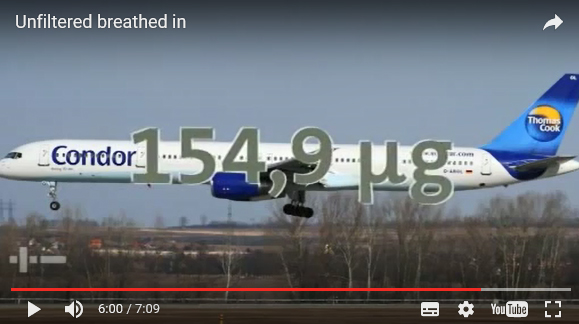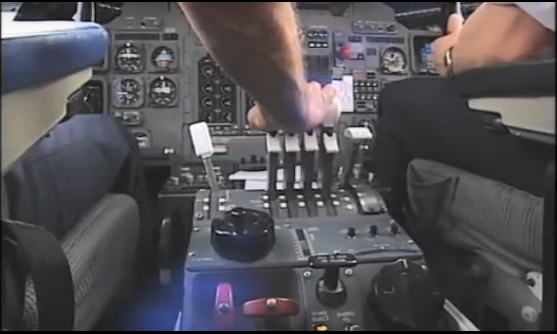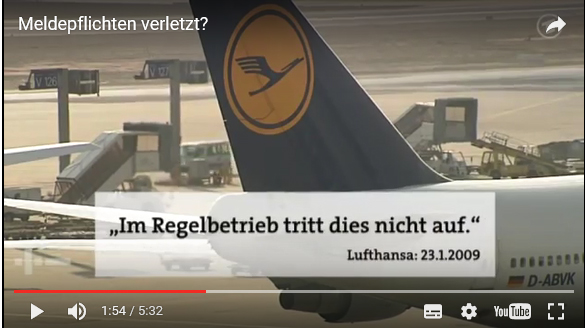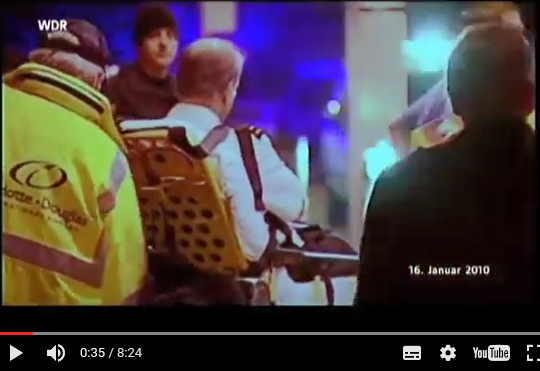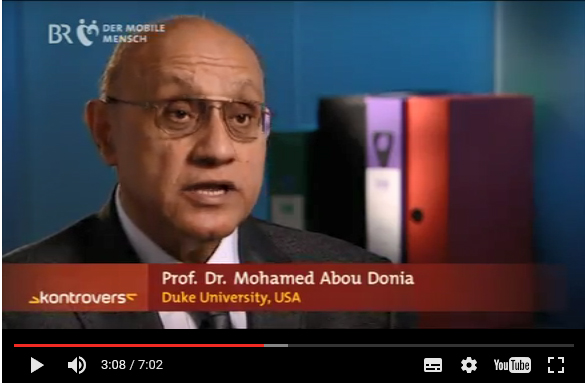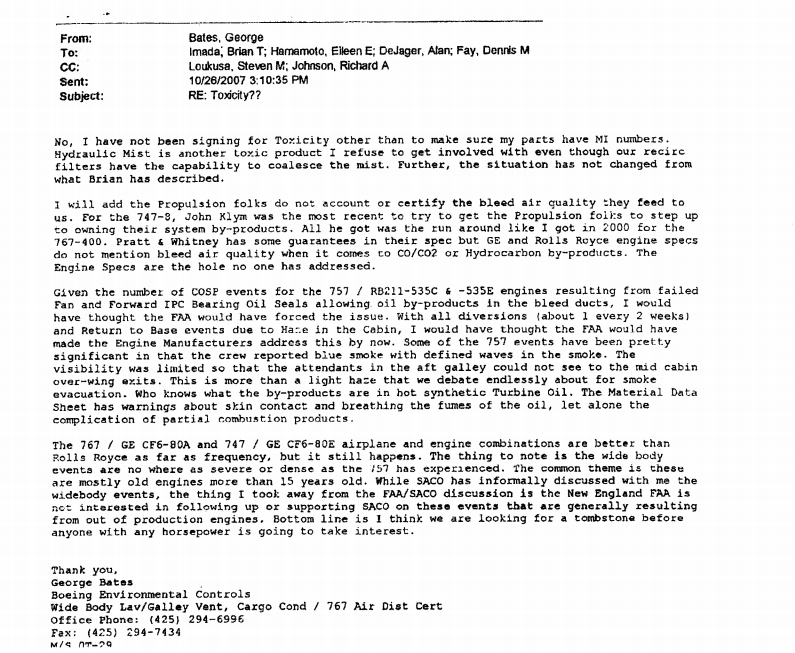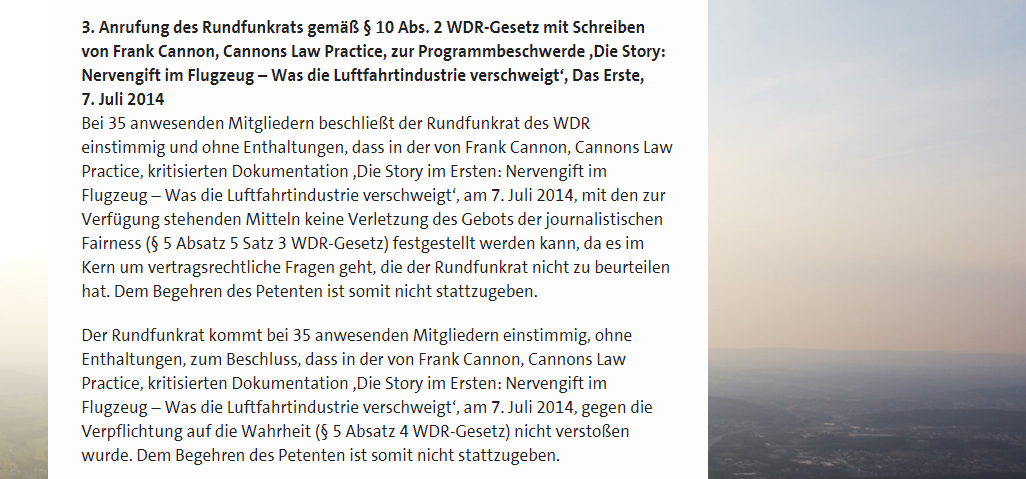
Tim van BEVEREN and the WDR documentary "Nervengift im Flugzeug" ("Nerve Poison in Aircraft"): Chronicle of a film making, which turned into 2 (different) documentaries
This reconstruction is the result of our research and a lot of information from filmmaker Tim van BEVEREN. The ‚Westdeutscher Rundfunk’ (WDR) refused answers to our questions. They simply did not respond to our press enquiry, for which we gave them a whole week to react to.
The History
Journalist and filmmaker Tim van BEVEREN has been working on the topic of "aerotoxic syndrome" since 2007. He has a pilot license, so he knows how to fly airplanes and most importantly how they work behind the sometimes complex user interface, and where hidden problems lie. For example, the bleed air: the cabin air is "tapped" via the engine, and sometimes it is contaminated. In other words, ‚contaminated’ when i.e. a seal leaks . More details about this can be found at www.ansTageslicht.de/CabinAir.
Tim van BEVEREN's career is diverse: aviation expert, author, cameraman and journalist. For several years he was in the former Yugoslavia and Iraq as war correspondent, and correspondent for private media companies in the USA. He worked mainly as a freelancer for public television in Germany. Especially for the WDR. He had a very close working relationship with this large and influential broadcaster for almost 30 years. However, this was to change during the course of the production of the documentary "Nervengift im Flugzeug" ("Nerve Poison in the Airplane") for the WDR.
Since 2008 Tim van BEVEREN had been repeatedly active for the WDR regarding the problem of potentially contaminated cabin air in aircraft. In 2011, he was invited to attend an expert panel hearing in the German Bundestag: as a specialised journalist and expert. Read more about this in the chronology A health problem becomes a certainty, there the entries from 21 September 2011.
Between 2009 and 2011, Tim van BEVEREN presented the problem to the public in several TV reports. Mainly at the public TV station WDR, which, in contrast to the private stations, who are financed by advertising, also broadcasts critical television formats :
* WDR / plusminus on 3rd February 2009: unfiltered breathed
WDR authors had taken air and wipe samples on various flights and had them tested in a specialised laboratory: Tricresyl phosphate (TCP) was detected in 28 of 31 samples/ flights. Samples from Condor flights showed the highest concentrations. Condor refused a statement.
Instead, Condor said: "For Condor, the safety and health of passengers and employees always have the highest priority.“
* WDR / Markt on 9th February 2009: Toxic airlines and the aerotoxic syndrome
This is the moment when those who are affected had their say. Among others, the former Australian pilot Susan MICHAELIS who became unable to fly due to fume event incidents.
All confirm that such incidents occur more frequently than is officially known and admitted.
More about this under "Incidents": Incidents that mostly do not appear in the official statistics.
* WDR / Plus-Minus on 24th March 2009
The third film: another incident that had not been reported. Prof. Dr. Dietrich HENSCHLER (†), toxicologist and for many years chairman of the MAK Commission (= Maximum Workplace Concentration), comments on the hazardous nature of contaminated cabin air: Tricresyl phosphate (TCP) is an "extremely effective toxin". There are other people affected, including the pilot Sandy VERMEER (pseudonym).
The film makes it clear that politicians are failing - the Federal Government has no "knowledge about a fundamental hazard" problem, they say.
* WDR / Markt on 16th March 2010
Tim van BEVEREN's fourth film: Incidents at Lufthansa, US Airways and others confirmed. Lufthansa: 1 incident on 2,000 flights. Which means with approximately 1 million Lufthansa flights per year: at least 1 incident per day.
And: Not only the tricresyl phosphate can enter the cabin air during these fume events, but also the harmful beta-naphthylamine. The result: health problems with the symptoms of "aerotoxic syndrome". This is confirmed by Prof. Dr. Chris WINDER (Australia) and Prof. Dr. Mohamed ABOU-DONIA (USA).
This can happen to anyone when flying.
* BR / ‚Controversial’ on 26th May 2011
American pharmacologist and biologist, Prof. Mohamed ABOU-DONIA, explains exactly what happens in the human organism when toxic substances enter the body:
"We found evidence of cell death and brain injury in all flight crew samples. There is no doubt that passengers are also affected, but the problem is, that they usually don’t relate the ill-health symptoms to a flight they were on. They therefore do not relate ill-health to oil fumes, but rather to an infection."
Richard WESTGATE and the WDR
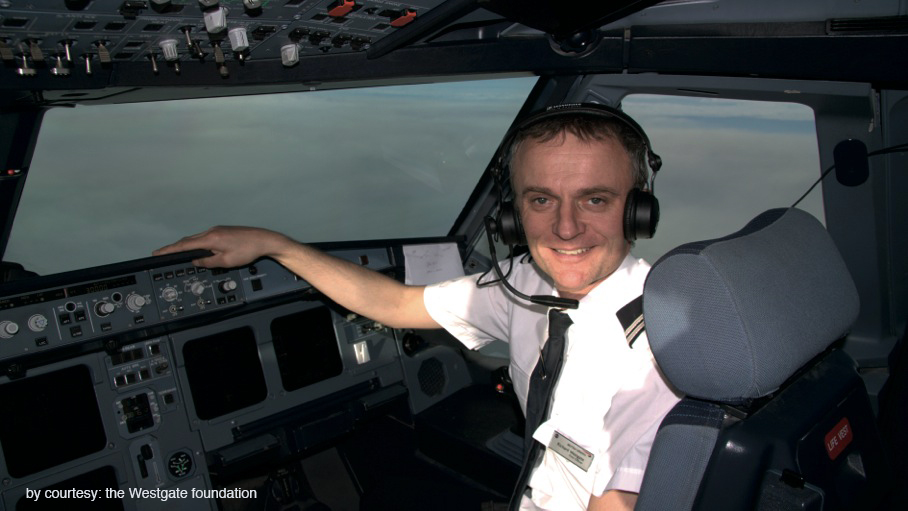
A few months earlier, in January 2013, Tim van BEVEREN received his first research commission from Georg RESTLE, head of the renowned WDR magazine "Monitor", for the newly formed "Investigative Department" of WDR. It quickly turns out that the material on Richard WESTGATE is so productive that it would be suitable for a longer documentary. Van Beveren had already produced two contributions on this topic for the well-known investigative magazine "Monitor".
This is how Tim van BEVEREN set about his research. In the times of social media, he is offered additional material - more and more often passengers, or members of cabin crew can authentically report almost in real time about fume events and other occurrences happening, by uploading their own pictures to the social networks. For this purpose van BEVEREN also adapts his Facebook account in order to get in contact with potential victims.
He shows some of these spectacular photos to the designated WDR editor-in-chief Sonja MIKISCH, with whom he built up a good relationship of cooperation over the years and for whom he had already worked in the 1980s. She is very interested in the making of a 45-minute documentary and supports the project at WDR and at the ARD editors-in-chief conference. The downfall: the events surrounding the pilot Richard WESTGATE and the scientific investigation of his autopsy.
The WDR - in person of Sonja MIKISCH - as producer and the "Westgate Research Team" around the scientific director of the investigations, Prof. Dr. Jeremy RAMSDEN , Dr. MULDER, Dr. Van de GOOT and Prof. ABOU-DONIA from the USA agree in a written document in English language, in which Tim van BEVEREN is expressly referred to as "author and editor". Some time later, the WDR promised a primetime airing slot on the ARD evening programme.
The documentation is approved in summer 2013 and production will start immediately thereafter. It will take until spring 2014, when Tim van BEVEREN wants to fly around the world in different types of aircraft, while taking air , wipe and blood samples, when visiting experts in Australia and the USA.
Jo ANGERER, who is in charge of the "Die Story" show, is named as the WDR editor responsible for the programme. However, ANGERER is rather sceptical about the topic. The topic had already been offered several times to the "Die Story" editorial team by WDR's business editorial department, and ANGERER had rejected it just as often.
The first problems already before the shooting
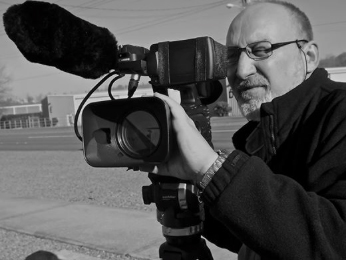
In the meantime, it has become customary for television stations to have at least two authors responsible for larger productions. Tim van BEVEREN requests a former colleague from NDR, with whom he had worked quite often. And the NDR documentary director had also signalled their interest in a co-production to both of them. Jo ANGERER, on the other hand, wants to keep the topic at WDR and nominates a WDR editor: Dr. Roman STUMPF.
But shortly before filming begins in Ireland, where a former Lufthansa chief stewardess is suing her former employer in the High Court, Jo ANGERER, the editor in charge, pulls a stop:
- He assigns a camera man to the project, even though there is a much cheaper team on site, with whom van BEVEREN had already shot several films. British former Gulf Air stewardess, Angel BRAIN from Wales is also familiar with this type of thing. She lives on miserably low benefits and had travelled to Cologne - initially at her own expense since Roman STUMPF had promised to reimbourse her. This was no longer the case. A scandal follows and Angel BRAIN withdraws all rights to the interview and no longer wants to have anything to do with WDR.
This triggers fierce discussions in relevant social media channels. Doubts about WDR's intentions arise. Tim van BEVEREN tries to counter this by posting regularly. - Then, Jo ANGERER cancels the trip and the planned expert interviews altogether: because of the costs involved. Although the ARD has already provided a production volume of almost €80,000 for expenses for the project.
Van BEVEREN is looking for a solution and finally offers to save them money on the sometimes high team costs, especially when abroad, by filming himself during this trip, in return for appropriate remuneration and reimboursment of the costs for his own equipment. For Jo ANGERER this is by no means a novelty, as he also produces many of his own films for WDR in this way.
Finally the trip is approved with a considerable delay. But the previously much cheaper flight costs have now become more expensive. Since interviews are generally to be shot with two cameras, around 100 kg of luggage also needed to be transported.
Lufthansa (based in Cologne) and WDR (based in Cologne)
After returning from filming around the world a meeting is held at the WDR: Jo ANGERER, Roman STUMPF and Tim van BEVEREN and, Barbara SCHÄDLER and Andreas BARTELS from Lufthansa. SCHÄDLER is responsible for communications and BARTELS is head of the press office. Lufthansa would like to know more details about the production.
Tim van BEVEREN confronts the Lufthansa delegation with an explosive internal email from the Boeing Group. Subject: "Toxicity?“
In this internal mail, a Boeing employee describes the technical defects in the aircraft and the resulting reasons for the recurring fume events. He also considers consequential health damage to be probable. And, he cannot resist the opinion, that a "tombstone" is needed before anyone is prompted to act.
First a disaster with many dead or tombstones? Tim van BEVEREN came across this mail in the course of his research. Now he asks Lufthansa, who also use aircraft from this manufacturer, to comment on these statements. And Jo ANGERER also surprises with a request to Lufthansa, which he had not discussed with Tim van BEVEREN: WDR would like to accompany a flight on which Lufthansa was carrying out measurements, to take their own measurements, and additionally asked the airline for an oil sample.
Lufthansa wants a "reflection period".
A few weeks later Lufthansa cancels the request to make a statement in front of the camera and any further cooperation.

A justification followed in an email to Roman STUMPF dated 17.02.2015: "Several pictures were found on the Internet that were "quite obviously taken on board our aircraft" and because "these pictures show clearly and unequivocally“ what Lufthansa can expect from this planned documentation, Lufthansa "decided against cooperation".
Attached to the email is a photo showing a hand taking a wipe sample from the ventilation duct of an on-board toilet and a picture of a woman in the passenger cabin wearing a breathing protection mask (see photos).

Tim van BEVEREN had previously uploaded the pictures to his Facebook account after voices had been raised there that the documentary planned for April 2014 would not be shown and that protagonists had spoken disparagingly and angrily in forums about the treatment and unfulfilled promises by Roman STUMPF and WDR.
Lufthansa somehow managed to get the pictures, and that even in their original size. This is unusual, since pictures are always small format (resolution) when uploaded to social networks. Van BEVEREN had only made the originals accessible to a small circle of WDR employees involved. How and above all why then did Lufthansa get them in high resolution?
WDR reacts quickly: Lufthansa receives an email from Jo ANGERER. He tries to appease the airline and points out that he would personally take over the whole film before the show anyway, i.e. he would answer for it.
And he tells Lufthansa in no uncertain terms: "Film author, as I said, is Dr. Roman Stumpf. Tim van BEVEREN only has the role of an ‚expert co-author’.“
Lufthansa is still not reassured by this, but revealed where they got the incriminating photos from, which "clearly and unambiguously showed what presentation" it had to expect in the planned documentary.
It is well known that press offices have many tasks and that includes 'enemy observation'. A good press spokesman knows everything, at least everything about critical spirits and those who take legal action against a company.
Lufthansa has learned that the photos were taken from a Twitter account, that of the Aerotoxic Team. There, according to the imprint, a former Lufthansa chief stewardess, namely Bearnaidine BEAUMONT was responsible for the page. She had sued Lufthansa unsuccessfully in Dublin - allegedly because of health damages she suffered following two fume events in Lufthansa planes (more about her under: Victims of Contaminated Cabin Air).
What Lufthansa knows: The former chief stewardess is one of the most important protagonists in the documentary and is looked after by Roland STUMPF.
Now the former chief stewardess is suddenly out of the picture - WDR editor Dr. Roman STUMPF drops her.

During the production tensions and arguments arise again and again.
At first, ARD and WDR decide to postpone the broadcast several times: instead of spring at a prime time, now it is postponed to May. Then from May to 7th July – to be broadcast during the time of the Football World Cup in Brazil. New time for the broadcast: 11.30pm
Meanwhile Tim van BEVEREN feels excluded from all internal communication of WDR. He travels to Cologne several times at his own expense, in order to not be left out completely. According to the new plans, all outstanding interviews will be conducted primarily by Dr. Roman STUMPF, the new or now, sole "author" of the WDR documentary.
Normally, so-called „concept discussions“ are held with the editors and authors involved before the editing begins. The aim is to clarify - very roughly - the direction which the finished piece should take, how research results should be weighted, what dramaturgy the film should follow and how the station should position itself in terms of content.
This production is different. Tim van BEVEREN's colleague, who - without BEVEREN knowing this - is supposedly the sole author, has no time for this. And there is only one conversation between the two: on a hotel balcony in Cologne.
The result: the documentary is divided, each one has to put his own part together. Tim van BEVEREN's editing will differ from that of his 'colleague' due to the abundance of material he has. But STUMPF hasn't even seen all the material yet.
So it happens that WDR editor-in-chief Sonja MIKISCH is 'not amused' when the film is accepted at the beginning of June - she obviously expected more. Jo ANGERER, on the other hand, agrees.
Tim van BEVEREN, who cannot defend himself, is also not happy - he has journalistic problems with the current version, which is divided into two parts. He dislikes for example, the exaggerated portrayal of the injured as 'victims'. He sees them as being „affected“ , many of whom are committed to clarifying the problem. And he misses the essential investigative elements from the research, some of which were passed on to him by insiders at high personal risks. He thinks that in the current documentary version many things are too ‚watered down’.
Thus Tim van BEVEREN offers WDR a "rough cut", i.e. a preview of another, more poignant version of the film - a version which, from his point of view, reflects the events in a more exciting and authentic way. Jo ANGERER rejects, and forbids him to edit the material at the same time. And this, although van BEVEREN is at least still officially the "author". According to WDR’s information given to Lufthansa, van BEVEREN is still an "expert co-author". After all, Tim van BEVEREN shot significant parts with his own camera and thus also owns the rights to the material.
The Show-down
In the mean time, the "Westgate Research Team" asks both the Scottish lawyer Frank CANNON and Freya von der ROPP’s lawyer, (the flight attendant who is shown in the film), to indicate the passages used in the film specifically concerning them for the purpose of their own agreed legal review.
Both received contradictory information from WDR within a few days. Freya von der ROPP’s lawyer receives the feedback that van BEVEREN is still "co-author". However, the previously concluded agreements with him had to be regarded as null and void. Lawyer Frank CANNON receives the explanation that Tim van BEVEREN is no longer the "author" of the planned documentation.
What WDR apparently did not know was, that the two lawyers know each other well because they both represent aviation clients. The communication of different information is therefore noticeable. The lawyers inform Tim van BEVEREN about this and ask him to comment, as well as requesting the assurance that he would continue to adhere to the written agreements made.
At this point, however, Tim van BEVEREN does not know the final version of the documentation. Jo ANGERER had informed him that he would not be part of the finalisation process and that he would make the necessary changes himself. Van BEVEREN protests against this highly unusual procedure, but still receives assurances from ANGERER on 26th June 2014 that he will see the final version and could then decide whether he wants to be named as "author" or not.
On July 1st, WDR and ARD advertise the film in their programme announcements with the words: "a film by Tim van Beveren and Roman Stumpf".
One day later van BEVEREN receives an email. Not from WDR, for whom he had worked on this topic for almost 3 years. The email is from Michael LAMBERTY, the press spokesman for Lufthansa in Frankfurt.
He informs the journalist that he has heard from WDR that van BEVEREN is no longer the "expert co-author" of the documentary planned for the next week. And Lufthansa wants to know more about the background:
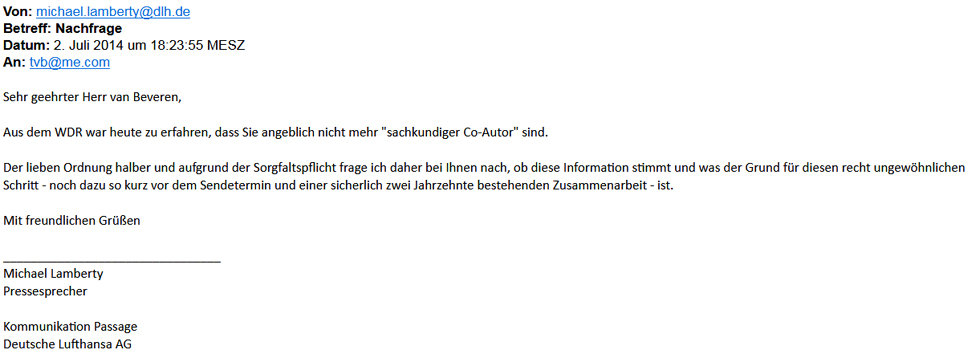
Tim van BEVEREN reacts on the spot and contacts the WDR via his lawyers to request a review of the final version of the film. He feels a duty - to the lawyers of those affected, but above all to the protagonists with whom there had been clear journalistic agreements.
That does not succeed. Jo ANGERER and WDR do not provide any further information and do not show him the final version before the broadcast.
This may have something to do with the fact that ANGERER and STUMPF had now put their own stamp on the documentary. ANGERER agreed with the first rough version, which the editor-in-chief Sonja MIKICH had not liked very much.
In the meantime further changes have been made here and there, of which Tim van BEVEREN knew nothing and which made a big impact on the viewer's understanding of the content. For example in an interview with the pharmacologist and cancer biologist Prof. Mohamed ABOU-DONIA from the USA, who had come to London as one of the experts in connection with the evaluations of the WESTGATE Research Team:
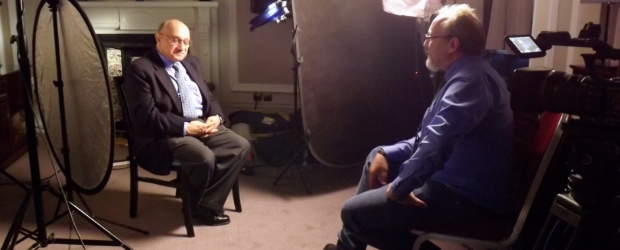
The interview was conducted by Tim van BEVEREN over about 40min. Then Roman STUMPF showed up, just arriving in London from Cologne and he also asked questions over about 8min.
And this is the result in the WDR documentary "Nervengift im Flugzeug" on July 7th, 2014. One example:
- Tim van BEVEREN’s (TvB) Interview with ABOU-DONIA (AD) Original version:
AD: "The sample that we received before your flew were completely normal. (…) It seems like: The more you flew, the more you had markers which interflect injury to the brain. In other words: When you were exposed longer to the chemicals it caused the brain injury and we could see the marker for it in the blood."
TvB: "So, does it mean now I’m sick?"
AD: "Not necessarily. Because what we saw was a plib. In order for you to become really sick you have to fly longer. Because keep in mind the body and the brain have the ability to repair until a certain point where it then cannot be repaired. We have billions of brain cells but if there is too much damage the brain cells will be fewer and there will also be functional damage."
- In the documentary broadcast by WDR Roman STUMPF had swopped the middle answer:
AD: "The sample that we received before your flew were completely normal. (…) It seems like: The more you flew, the more you had markers which interflect injury to the brain. In other words: When you were exposed longer to the chemicals it caused the brain injury and we could see the marker for it in the blood."
RS:( in German): "Am I now injured by organophosphates or contaminated cabin air? - AD: "Not necessarily. Because what we saw was a plib. In order for you to become really sick you have to fly longer. Because keep in mind the body and the brain have the abilty to repair until a certain point where it then cannot be repaired. We have billions of brain cells but if there is too much damage the brain cells will be fewer and there will also be functional damage."
This is the answer we received to that question:
As mentioned above: none.
We must therefore assume that WDR has no answer to this question. This is often the case: When asked about things that seem obvious, they often have no explanations.
The Scottish lawyer Frank CANNON sees it like this in his “programme complaint” to the WDR of 9th September 2014:
"Here the viewer is deceived." Such a procedure is "extremely questionable from a journalistic point of view" and "unethical" (Programme Complaint p. 8).
And CANNON claims even more "false" representations in the WDR documentary, in addition to the violations of several contractual agreements.
Tim van BEVEREN learns even more:
At the end of an interview with the head of EASA conducted for the documentary, Roman STUMPF talks to him again and explains frankly and freely - supposedly unobserved, when going out: "I have to have this position for the interview, it doesn’t mean I'm like that."
This sentence was recorded by chance, because, during a shoot the microphones usually stay on. But where does Roman STUMPF's special attitude in this case come from? What does he want to signal to the EASA director?
Frank CANNON would find out soon. After the numerous unusual things happening around the production, he begins to do his own research and also passes on his findings to Tim van BEVEREN, who then does what he does best: investigative research. This time about his former WDR colleague. And he finds what he is looking for:
Dr. Roman STUMPF not only holds a doctorate in law and is a fuly employed editor for public law with broadcasting responsibility at WDR ‚Wirtschaftsredaktion’ in Cologne. Roman STUMPF is also once again a student.
However, he is not studying at an independent public university, but at the private ‚Quadriga University’ in Berlin. This university shows how closely it is linked to the industry and how they are financially supported by it, on their website. The school's "mentors" include, for example, leading representatives of large corporations. BMW, for example. BMW, in turn owns Rolls Royce - the company that produces the engines for many of the large passenger aircraft. Other aviation companies, such as Lufthansa or Airbus are and/or have been associated with the ‚Quadriga University’.
Roman STUMPF in any case, is currently doing his Bachelor's in "Networks" in Berlin. And he even receives an impressive scholarship - in addition to his WDR salary. In his letter of motivation tot he Quadriga University, Stumpf justified his interest in studying in such a way, that he "would like to work more in business in the future, preferably with a company like BMW".
Is there - possibly - a conflict of interest?
The WDR will later comment in a statement marked as a "FactCheck" about itself as the concerned broadcasting institution and its editor Roland STUMPF:
"At no time did his studies influence the content of Roman Stumpf's work for WDR. This also applies to his co-authorship of the documentary 'Nervengift' (Nerve Poison).
Afterwards
The WDR broadcasting council quickly smoothed out the programme complaint lodged by lawyer Frank CANNON:
From seven of the interviewed protagonists, six complain about promises not being kept - not counting Bernairdine BEAUMONT, the former chief stewardess of Lufthansa, who was left out after the posting of a photo showing her with a respirator mask. The former chief stewardess’s has been sick with nervous system and lung complications ever since she experienced two fume-event incidents; due to this she has to live at an altitude of 1,500 metres (Switzerland) and can only fly with an activated carbon mask. The photo is not fake.
These days the name Dr. Roman STUMPF can no longer be found at WDR. Nevertheless, Dr. Roman STUMPF is still employed. However: Dr. Roland STUMPF is no longer called Dr. Roman STUMPF. Dr. Roman STUMPF is now called Dr. Roman RUSCH and is an editor and correspondent at ARD Studio Brussels, where he now reports on European topics.
Since then, Tim van BEVEREN has received no more commissions - neither from WDR nor from ARD. He now devotes himself to those affected by aerotoxic syndrome and other projects.
The WDR film "Nervengift im Flugzeug - Was die Luftfahrtindustrie verschweigt" („Nerve Poison in Aircraft – Wha the aviation industry is silent about“) has never been broadcast again. Although the media coverage of fume events and their consequences is increasing. The WDR did not want to answer why the film was never broadcast again. We can only assume that a new broadcast would be too embarrassing for WDR.
But there is one film that you can watch: Tim van BEVEREN's cinema production, which we present here: The documentary that exists: „Unfiltered Breathed-In".
How does the discussion with the WDR continue? We discuss this under „Production without Ending? How the WDR is now taking Tim van BEVEREN into its grips.“
Anyone interested in the issue of potentially contaminated air in aircraft can read more here:
www.ansTageslicht.de/ENATLB (Aerotoxic Logbook in ENGLISH)
www.ansTageslicht.de/krankdurcharbeit (in German)
Online am: 13.12.2018
Aktualisiert am: 14.12.2018
Inhalt:
- Fume Events Worldwide
- What is different when we fly at 10 km altitude?
- Contaminated cabin air: a health problem becomes certainty. The chronology of the socalled Aerotoxic Syndrome
- "Incidents": Incidents that do not usually appear in official statistics
- Lufthansa’s subsidiary ‚Germanwings’: December 19, 2010
- Health, Science and Economic interests in Aerotoxic Syndrome
- An UNCOVERING of Tricks, Methods and Strategies, how to downplay fume events
- 1 Reviewer - 2 Opinions: Prof. Dr. Stephan LETZEL
- Occupational Medicine in Germany: "Misleading Representation"?
- Tim van BEVEREN and the WDR documentary "Nervengift im Flugzeug" (Nerve Poison in Aircraft“): Chronicle of a film making, which turned into 2 (different) documentaries
- What Can You Do ?
Tags:

